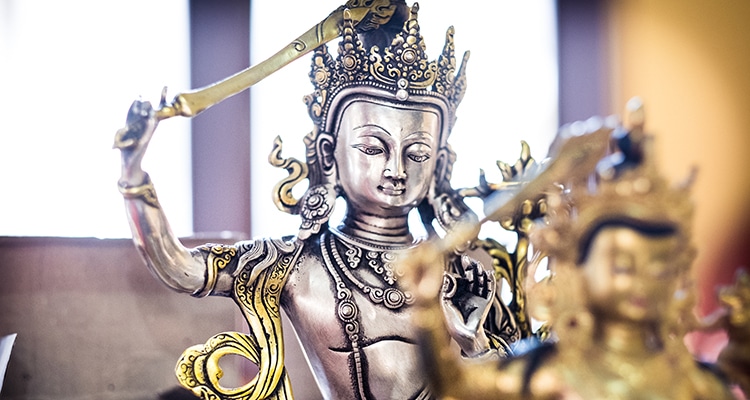Remedies to Agitation and Dullness
Category: Buddhist Meditation | Buddhist Path | How to Meditate | Mind Trainer Articles

Two classic obstacles to meditation, explained
When you’ve decided to meditate and work on training your mind, don’t assume that it’s going to be easy. There will be different obstacles to practicing meditation, and they all belong to one of two categories. On the one hand, there’s agitation: a very active mind that’s busy with thoughts and preoccupations. On the other, there’s dullness: a sleepy, sluggish mind. Dullness and agitation are the two main issues in meditation, and sometimes the mind swings from one to the other. We need to find balance instead of reacting so forcefully that the swing flies off in the opposite direction.
Outer Remedies to Agitation and Dullness
How can we deal with agitation? Here’s some very specific advice that we can put into practice. First, we can pay attention to outer influences. For example, I can check whether the room where I’m meditating is causing me more agitation. I can make sure there’s no mess lying around and try to position myself so there’s an open space in front of me. I might control the sound level, reduce the impact of light, and adopt a relaxed posture. If necessary, I may even want to eat a bit more—for those dealing with agitated states of mind, food that’s a little heavier is recommended. I can dress warmly so that my body relaxes and feels comfortable, and I can lower my gaze so that it settles on the ground. I simplify my way of functioning. The old masters gave a lot of practical advice like this about outer methods that help regulate agitation.
The same sort of advice is valid for dullness and sleepiness as well, but the remedies are just the opposite. For example, I can lift my gaze and open my eyes to the sunny sky or make the room a bit brighter. I can eat light food and take off my jacket. I may even sprinkle a little water on my face, open the window, and perhaps shift from sitting to standing or walking meditation. There are also helpful meditation postures that encourage my energy to circulate so I become more present. This is how I can use outer means to wake myself up and find balance. Again, it’s important not to overdo it—I want to counter dullness without encouraging agitation.
Inner Remedies to Apply in Meditation
While there are a number of outer remedies to both agitation and dullness, on the inner level we begin by recognizing that all obstacles to meditation are due to one factor and one alone: self-centeredness, or a preoccupation with oneself. Actually, if we were truly entirely committed to being present for the benefit of the whole, there wouldn’t be any thought chains! We wouldn’t encounter agitation and we wouldn’t look to drowsiness to keep us shielded from bright awareness.
Once we’ve acknowledged that all of the obstacles in meditation come from a preoccupation with self, it becomes obvious that the real antidotes to these difficulties involve more compassionate states of mind as well as more openness towards everyone and everything. I remain open and interested in learning more about myself, especially about the habitual tendencies that make me want to cop out. Until now, I haven’t really wanted to see these tendencies, but now I’m willing to open up and to explore them fearlessly.
Take dullness. Dullness often comes from wanting to avoid certain unwelcome feelings. When we’re devoted to all sentient beings, to helping everyone that comes to mind, we’re naturally encouraged to open and purify our hearts and minds for the benefit of all. This is a very powerful motivation for meditation; it wakes us up and we enter the process with enthusiasm: “Let’s see what’s going on today.” Very calmly and openly, we accept and work with whatever comes along. It’s the perfect antidote to dullness.
As for agitation, we see that the things that really agitate the mind are different kinds of hopes and fears. We like and want this; we don’t like or want that. Plus, we are often agitated by subtle worries about defending our good reputation, gains and profits, renown and recognition. Or it’s the opposite, and we’re worried about being criticized, about things not going so well and potentially having to accept loss or defeat. We call these “the 8 worldly entanglements” and they agitate the mind considerably.
We have to become aware of these obstacles and entanglements before we can effectively work on them. So very clearly, at the beginning of meditation, we call upon the watcher of insightful awareness to notice and identify the obstacles—the sleepiness, dullness, and sluggishness, or the agitation, over-excitement, and clinging—as they arise.
Because we’ve done what we can to reduce agitation due to outer factors, now we’re able to go deeper into the antidote to agitation, into the level of causes. When I’m agitated, why am I clinging so much? Where is it coming from? We go deeper and deeper. I might notice that it doesn’t always matter which thought I’m clinging to—I just want to give myself a feeling of being someone, just because I’m thinking. Once I’ve recognized this, I can relax it. There’s no need to think or to be angry just to prove my existence. There’s no need to entertain desire just to amuse myself. Through my practice, I can become familiar with relaxing into whatever stirs my mind up.
The same goes for sleepiness and dullness—they are also a form of tension and simply remaining open to this tension is helpful. Instead of relaxing out of the situation, I open into presence. Just like with agitation, by opening up and refraining from following after thoughts, they simply dissolve by themselves. I don’t have to do anything else; I’m just not collecting thoughts anymore.
We don’t have to chase after obstacles and apply antidotes all the time.
When your mind is open, tranquil, and calmly abiding, please don’t do anything. Just enjoy it. For a while, enjoy the clarity and lucidity of mind. These qualities are naturally there as soon as we allow them to express themselves.
We won’t have to chase after obstacles and apply antidotes all the time. When we’re balanced in the middle of the agitation and dullness swing, we needn’t manipulate or influence the mind at all anymore. We let it be just as it is.
While this is happening, we’re learning a lot. At first, when the obstacles are pacified, we’re learning about how this process works. After that, we begin to realize that we have a very fine mind. Our mind is naturally clear, naturally aware, naturally open. Simply by being open, the mind is happy. It is happy in and of itself.
For more teachings on Buddhist meditation by Lama Lhundrup check out our new progressive course series by clicking on the banner below.








